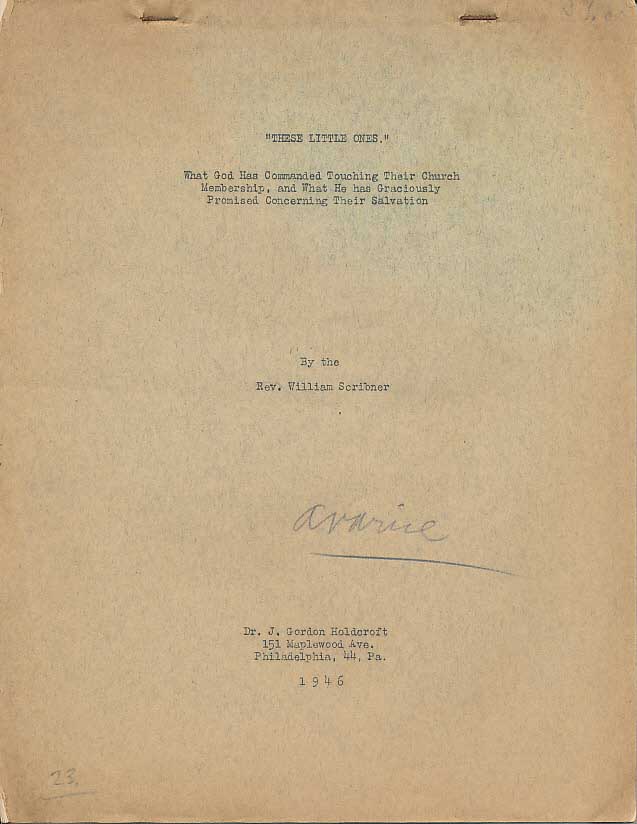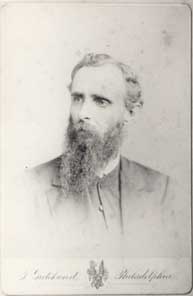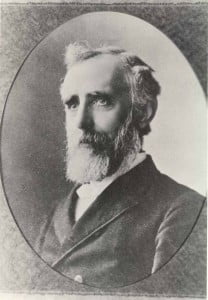The Cause Of The Doctrinal Trouble In The Northern Presbyterian Church, part 2
(“Exploring Avenues Of Acquaintance And Co-operation”)
By Chalmers W. Alexander
Jackson, Miss.
[THE SOUTHERN PRESBYTERIAN JOURNAL 8.14 (15 November 1949): 5-9.]
This is the ninth in the series of articles by Chalmers W’. Alexander under the heading, “Exploring Avenues of Acquaintance And Co-operation.” This is an informative new series of articles written by one of the most able laymen in the Southern Presbyterian Church.
When the reorganization of Princeton Seminary took place in 1929, four outstanding members of the faculty of Princeton Seminary voluntarily resigned their positions in that institution. And they left its campus, never to return.
At that time I was in my freshman year at Princeton University, which is located a few blocks’ distance from the campus of Princeton Seminary. Who were these four outstanding men?
The Scholars Who Left Princeton Seminary
One was Dr. J. Gresham Machen, probably the world’s greatest New Testament scholar at that time. Dr. Machen had received his A.B. degree from Johns Hopkins University, his M.A. from Princeton University, and his B.D. from Princeton Seminary. Then he had studied at the Universities of Marburg and Goettingen, both in Germany. Dr. Machen had been a member of the faculty of Princeton Seminary since 1906.
Another was Dr. Robert Dick Wilson, probably the world’s greatest Old Testament scholar at that time. Dr. Wilson had received his A.B. and his M.A. from Princeton University and his Th.B. from Western Theological Seminary. Then he had studied for two years at the University of Berlin prior to receiving his Ph.D. from Princeton University. Dr. Wilson, a great linguist, had mastered some two dozen languages collateral with Old Testament languages in order to throw light upon the Old Testament and its manuscripts. He had been a member of the Princeton Seminary faculty since 1900.
The third man was Dr. Oswald T. Allis, one of America’s greatest Old Testament scholars today. Dr. Allis received his A.B. from the University of Pennsylvania, his B.D. from Princeton Seminary, his M.A. from Princeton University, and his Ph.D. from the University of Berlin. Dr. Allis had been a member of the faculty of Princeton Seminary since 1910, and since 1918 he had been the Editor of The Princeton Theological Review.
And the fourth man was Dr. Cornelius Van Til, one of the ablest Professors of Apologetics in America at the present time. Dr. Van Til had received his A.B. from Calvin College, his Th.B. and his Th.M. from Princeton Seminary, and his Ph.D. from Princeton University. He had joined the Princeton Seminary faculty in 1928.
These four unusually great scholars left Princeton Seminary and, in association with other men of like mind, they proceeded to found Westminster Theological Seminary, at Philadelphia, in the autumn of 1929.
In this undertaking they were associated with such prominent ministers of the Northern Presbyterian Church as Dr. Maitland Alexander, a former Moderator of the General Assembly of that denomination, and long the President of the Board of Directors of Princeton Seminary until its reorganization in 1929; and Dr. Frank H. Stevenson, former Pastor of the Church of the Covenant in Cincinnati; and Dr. Clarence E. Macartney, a former Moderator of the General Assembly of the Northern Presbyterian Church, and the Pastor of the famed First Presbyterian Church of Pittsburgh.
All three of these prominent ministers had served as members of the Board of Directors of Princeton Seminary until its reorganization in 1929.
Why They Left Princeton Seminary In 1929
The reason why these unusually able scholars and ministers left Princeton Seminary in order to help found Westminster Theological Seminary was because they were firmly convinced that the reorganization of Princeton Seminary would result in serious changes being made in that institution’s hitherto consistently and thoroughly orthodox position in theology.
Some of the sound Princeton Seminary scholars stayed on at Princeton Seminary, after its reorganization in 1929, with the hope that they might so influence its affairs that the Seminary would continue to be consistently and thoroughly orthodox in its position. Dr. Casper Wistar Hodge, Ph.D., was one of this number; but by the time of his death, in 1937, Dr. Hodge had lived to see that his hopes of keeping Princeton Seminary consistently and thoroughly orthodox in all of its teachings had been in vain.
Some Developments Since The Reorganization
A brief review of some of the events which have taken place at Princeton Seminary since its reorganization in 1929 will show that the belief of Dr. Machen and his associates that the reorganization would result in serious doctrinal changes was not without foundation.
For instance, after the reorganization occurred in 1929 signers of the heretical Auburn Affirmation were for the first time placed on the Board of Trustees which controls Princeton Seminary; this was done apparently with the implied consent of the other members of the Board who remained after the reorganization. And in the school year 1937-1938 an Auburn Affirmationist taught in the Seminary as visiting Professor of Homiletics.
Dr. Emil Brunner At Princeton Seminary
During the school year 1938-1939, Dr. Emil Brunner, of Zurich, Switzerland, occupied the position of Professor of Systematic Theology at Princeton Seminary — the faculty professorship which had been made world-famous by the Hodges and toy Dr. Warfield. The Board of Trustees of the Seminary actually offered Dr. Brunner that professorship as a regular continuing member of the Seminary’s faculty, but he declined the offer.
Now Dr. Brunner is a very able scholar and he had previously raised a vigorous voice against some of the Modernism in Europe. But his own views have themselves been called the “New Modernism” by some of the ablest theologians in this country.
In his book entitled Man In Revolt, Dr Brunner specifically rejects belief in the Virgin Birth of the Lord Jesus Christ.
Dr. Brunner’s views on the inspiration of the Holy Bible are certainly far from adequate. For example, in The Presbyterian, issue of February 17, 1938, he wrote: “It is, however, my conviction that faith in the inspiration of the Bible does not exclude, but includes, the distinction between the Word of God and the earthly, temporal vessel which carries it.” The “earthly, temporal vessel which carries it” is, of course, the Holy Bible. In other words, Dr. Brunner does not believe that all of the Bible is the Word of God.
He substitutes human experience for the Bible as the ultimate standard of truth. As Dr. Cornelius Van Til, Ph.D., states: “That Brunner begins with experience as something that must interpret the Bible, instead of starting from the Bible which must interpret human experience, can be seen from the fact that he has no hesitation in accepting the principles of ‘higher criticism.’ He even feels that it is our business to engage in ‘higher criticism.’ The human element in the Scripture, he thinks, is inherently wrong and we must separate it from the divine.”
This attitude toward the Holy Bible is certainly radically different from the view held by the Hodges and by Dr. Warfield, and it constitutes a radical departure from the view contained in the Westminster Standards.
If Dr. Brunner had been appointed a professor in Union Theological Seminary of New York City, or in the Department of Religion of Princeton University as it is today, or at Yale, or at Harvard, or at the Chicago Divinity School, for instance, there would have been great rejoicing among the Conservatives, for that would have represented a great step upward for those institutions. But for Dr. Brunner to occupy the chair of Systematic Theology which had formerly been occupied by the Hodges and by Dr. Warfield at Princeton Seminary represented a decided step downward for that institution.
How One Minister Became A Regular Member Of The Faculty
Another illustration which shows the change in Princeton Seminary’s attitude since 1929 concerns the appointment to its faculty of a certain minister in the year 1939.
Under the copyright date of 1936, this minister had written a book entitled Christianity in America wherein he stated, among other things: “Few intelligent Protestants can still hold to the idea that the Bible is an infallible book; that it contains no linguistic errors, no historical discrepancies, no antiquated scientific assumptions, not even bad ethical standards. Historical investigation and literary criticism have taken the magic out of the Bible and have made it a composite human book, written by many hands in different ages.”
Clearly the views expressed by him in 1936 were at very serious variance with the views of the inspiration of the Bible which are contained in the Westminster Standards, and this fact was not unknown to those in control of Princeton Seminary. And yet, in spite of this fact, the Board of Trustees of Princeton Seminary elected this minister to serve as a professor in the Seminary for the school year 1938-1939. When, however, the General Assembly of 1938 met, its Standing Committee on Theological Seminaries failed to confirm his appointment as a professor. And, accordingly, the Seminary’s Board of Trustees withdrew his name.
Now only fifteen days before the meeting of the following General Assembly, the General Assembly of 1939, there appeared in The Presbyterian, under the date of May 11, 1939, an article, written by this minister, which was entitled “Convictions”—and in this article he took an entirely different view from that expressed in his book published in 1936.
When the General Assembly of 1939 met, his name was again submitted for confirmation as a professor in Princeton Seminary, and the minister in question personally appeared before that General Assembly’s Standing Committee on Theological Seminaries. A member of the Standing Committee on Theological Seminaries at that time was Mr. C. D. Garrard, of Covington, Kentucky, who was then a Ruling Elder in the Northern Presbyterian Church. Mr. Garrard later wrote an article in which he stated that this minister, in the Committee hearing, in answer to some questions asked by Mr. Garrard, stated that he had been considered thoroughly orthodox when he had graduated from Princeton Seminary, and he had changed his theological position a number of times in the past fifteen years. Mr. Garrard then asked what had caused him to change his views between the 1938 and the 1939 General Assembly meetings, and this minister had replied that he “just grew up.”
After this hearing, the Standing Committee on Theological Seminaries, by a majority vote, then decided to recommend that this minister be confirmed as a professor in Princeton Seminary, although Mr. Garrard voted against it. The General Assembly of 1939 then proceeded to confirm the minister’s appointment to the faculty of the Seminary, and he is still a member of that faculty at the present time.
In all of this the significant fact is that those in control of Princeton Seminary were perfectly willing to elect this minister to a position on the faculty of that seminary months prior to the publication of his article entitled “Convictions”; and the only thing that kept him from becoming a member of the Seminary’s faculty in 1938 was the failure of that Assembly’s Standing Committee on Theological Seminaries to confirm his appointment after the Board of Trustees of Princeton Seminary had submitted his name for confirmation.
(In passing, it is indeed interesting to note that Mr. C. D. Garrard, of Covington, Kentucky, stated that after he had become interested in the affair of the Auburn Affirmation, and after he had attended the 1939 General Assembly of the Northern Presbyterian Church as one of its Commissioners, he resigned his office as a Ruling Elder and he severed completely all of his connections with the Northern Presbyterian Church. Mr. Garrard is now a Ruling Elder in the Southern Presbyterian Church, and recently he informed me that he is one hundred per cent opposed to the proposed union between the Northern Presbyterian Church and our own denomination.)
Evidence From The New Westminster Bible
A recent illustration of the fact that the reorganization of Princeton Seminary in 1929 opened the door for doctrinal unsoundness to enter into the teachings of that Seminary is the new Westminster Study Edition of the Holy Bible.
This Westminster Study Edition is now sometimes referred to as the “Presbyterian Bible.” It was published by the Westminster Press, a subsidiary of the Northern Presbyterian Church’s Board of Christian Education (which Board has had among its membership, from time to time, various signers of the heretical Auburn Affirmation)..
Three professors from the faculty of Princeton Seminary were among the eleven editors of this Westminster Study Edition of the Holy Bible.
Now what is the tenor of the editorial comments and explanations contained in this Westminster Study Edition?
Dr. Oswald T. Allis, Ph.D., has written that “the Study Edition is definitely critical,, at times even radically so.”
Dr. William Childs Robinson, Th.D., of our Columbia Theological Seminary, has remarked that the editors of the Westminster Study Edition seem hesitant to call Christ God, and that their whole doctrine of the Deity of Christ is weak.
In addition to being weak on the doctrines of the Inspiration of the Bible and of the Deity of Christ, the Study Edition is far from strong in its statements on the Reformed doctrine of the Atonement and Justification. It was such doctrines as these that the great Princeton theologians of the past like Archibald Alexander, Charles Hodge and Benjamin B. Warfield exalted, and it was in these doctrines that they glorified.
Even such a secular magazine as Time has stated that, though this Study Edition sticks to the traditional King James wording, “it is far from conservative in commenting on it.”
And yet three professors from the faculty of Princeton Seminary were among the editors of this Westminster Study Edition.
It is certainly safe to say that none of the great theologians at Princeton Seminary during the time of the Hodges and of Dr. Warfield would ever have consented to have their names associated with an edition of the Bible which, in its editorial comments and explanations, can in so many instances be termed as “definitely critical, at times even radically so,” and as being “far from conservative.”
Princeton Seminary Since 1929
It is not our purpose in this article to affirm or to deny that there are sound men on the faculty of Princeton Seminary at the present time. No one, however, can contend that, since its reorganization in 1929 which resulted in “new School” theology being introduced into its teachings, Princeton Seminary’s faculty has been as consistently and as thoroughly orthodox as it was in the days of the Hodges and of Dr. Warfield.
Since 1929, Princeton Seminary, either through members of its administrative personnel or as a part of its policy as an educational institution, has been following the course of doctrinal inclusivism. The enthusiastic co-operation of one of the Seminary’s most prominent officials in the organization of the World Council of Churches—a movement which no one can claim is consistently orthodox—is a recent case in point. Some very able Presbyterian ministers and theologians are of the opinion that Princeton Seminary is traveling a route which will lead ultimately to surrender to Modernism, unless it changes its course.
New School” Theology And The Northern Presbyterian Church
Wherever the liberal “New School” theology has taken root in the Northern Presbyterian Church it has caused serious trouble.
In fact, the principal cause of the doctrinal trouble in the entire Northern Presbyterian Church is the presence in that denomination of the liberal “New School” theology and of the Modernism which it has so often helped to promote.
If We Were To Unite
If the proposed union between our Southern Presbyterian Church and the very much larger Northern Presbyterian Church were to take place, we could rest assured that certain changes would be forced upon all of our seminaries so that the liberal “New School” theology could be taught in them side by side with the conservative “Old School” theology, which conservative “Old School” theology has always been the official doctrinal belief of our denomination since its founding.
Frankly and candidly, in some of our seminaries at the present time there are reported to be some strong influences which are tending definitely toward Modernism. But these reported influences have not been authorized by our General Assembly. Incidentally, it is the opinion of a large company throughout our denomination that it is now time for our General Assembly to appoint a competent committee charged with the responsibility of examining these seminaries with a view toward overhauling them, if need be, so that all of their teachings will conform completely to the teachings of the Holy Bible as they are summarized in the Westminster Standards.
Now if the proposed union with the Northern Presbyterian Church takes place, we can rest assured that all of our seminaries will be overhauled —tout the purpose of their reorganization after the proposed union will be, not to bring their teachings more into conformity to the teachings of the Bible as they are summarized in the Westminster Standards, but to put the official stamp of approval upon introducing the liberal “New School” theology into their teachings!
What shall every Southern Presbyterian, as a Bible-believing Christian who repudiates completely the liberal “New School” theology and who rejects altogether the Modernism for which it has so often helped to prepare the way, say with regard to the proposed union with the heresy-tainted Northern Presbyterian Church?
Thou Shalt Say, No!




